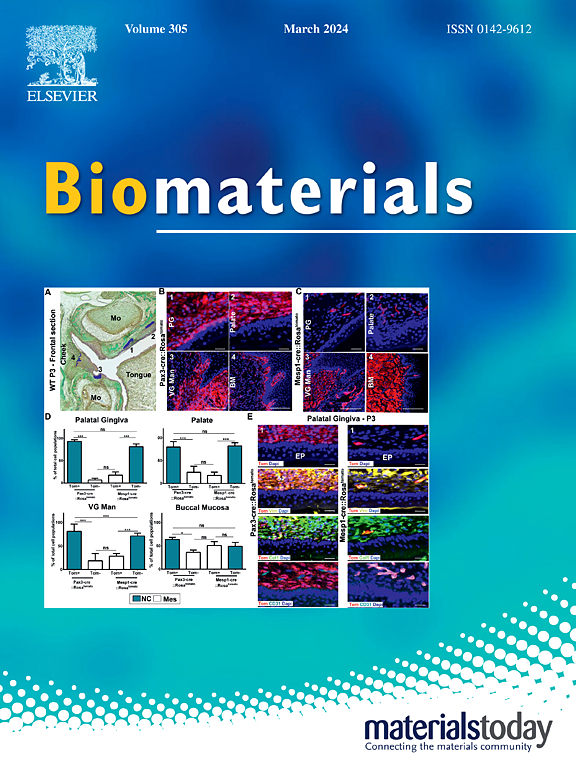In vivo brown adipogenic reprogramming induced by a small molecule cocktail
IF 12.9
1区 医学
Q1 ENGINEERING, BIOMEDICAL
引用次数: 0
Abstract
Research on the browning of adipocytes has been increasing in recent years owing to the prevalence of lifestyle diseases such as obesity and diabetes. Accumulation of brown fat enhances energy expenditure and could be a strategy to fight obesity. While approaches to induce browning in animals for therapeutic purposes have been tested, clinically applicable options are limited. Here, we propose chemically induced in vivo brown adipogenic reprogramming for the therapeutic application of brown adipocytes. By phenotypic screening, we identified a novel combination of two small molecules, SB431542 (SB) and NKH477 (NK), a TGFβ inhibitor and a cAMP activator, respectively, that could reprogram mouse embryonic fibroblasts (MEFs) to adipocyte-like cells with brown/beige adipocyte properties. We demonstrated that the expression of both Pparγ and Cebpβ via TGFβ inhibition and cAMP activation is essential for the increased activation of UCP1 due to the synergistic effects of SB and NK combination (SBNK) on adipogenesis. We further demonstrated the potential clinical application of this in vivo brown adipogenic reprogramming by showing that high-fat diet (HFD)--fed mice treated intraperitoneally with the SBNK exhibited enhanced browning capacity and were protected from HFD-induced impairment of glucose metabolism. Finally, microneedle patches embedded with SBNK-loaded nanoparticles were applied to the mice's skin around subcutaneous white adipose tissue to test the efficacy of local delivery, which also showed a browning effect. Taken together, a novel combination of small molecules that synergistically induced browning with far-reaching translatable therapeutic potentials was developed in this study.
一种小分子鸡尾酒诱导的体内棕色脂肪重编程
近年来,由于肥胖和糖尿病等生活方式疾病的流行,对脂肪细胞褐变的研究越来越多。棕色脂肪的积累增加了能量消耗,可能是对抗肥胖的一种策略。虽然已经测试了用于治疗目的的动物诱导褐变的方法,但临床适用的选择有限。在这里,我们提出化学诱导体内棕色脂肪生成重编程用于棕色脂肪细胞的治疗应用。通过表型筛选,我们发现了两个小分子的新组合,SB431542 (SB)和NKH477 (NK),分别是TGFβ抑制剂和cAMP激活剂,可以将小鼠胚胎成纤维细胞(mef)重编程为具有棕色/米色脂肪细胞特性的脂肪细胞样细胞。我们证明,由于SB和NK组合(SBNK)对脂肪形成的协同作用,通过TGFβ抑制和cAMP激活,Pparγ和Cebpβ的表达对于UCP1激活的增加是必不可少的。我们进一步证明了这种在体内棕色脂肪生成重编程的潜在临床应用,通过显示腹腔注射SBNK的高脂肪饮食(HFD)喂养的小鼠表现出增强的褐变能力,并保护其免受HFD诱导的葡萄糖代谢损伤。最后,将装载sbnk纳米颗粒的微针贴片植入小鼠皮下白色脂肪组织周围的皮肤,测试局部递送的效果,也显示出褐化效果。综上所述,本研究开发了一种新的小分子组合,可协同诱导褐变,具有深远的可翻译的治疗潜力。
本文章由计算机程序翻译,如有差异,请以英文原文为准。
求助全文
约1分钟内获得全文
求助全文
来源期刊

Biomaterials
工程技术-材料科学:生物材料
CiteScore
26.00
自引率
2.90%
发文量
565
审稿时长
46 days
期刊介绍:
Biomaterials is an international journal covering the science and clinical application of biomaterials. A biomaterial is now defined as a substance that has been engineered to take a form which, alone or as part of a complex system, is used to direct, by control of interactions with components of living systems, the course of any therapeutic or diagnostic procedure. It is the aim of the journal to provide a peer-reviewed forum for the publication of original papers and authoritative review and opinion papers dealing with the most important issues facing the use of biomaterials in clinical practice. The scope of the journal covers the wide range of physical, biological and chemical sciences that underpin the design of biomaterials and the clinical disciplines in which they are used. These sciences include polymer synthesis and characterization, drug and gene vector design, the biology of the host response, immunology and toxicology and self assembly at the nanoscale. Clinical applications include the therapies of medical technology and regenerative medicine in all clinical disciplines, and diagnostic systems that reply on innovative contrast and sensing agents. The journal is relevant to areas such as cancer diagnosis and therapy, implantable devices, drug delivery systems, gene vectors, bionanotechnology and tissue engineering.
 求助内容:
求助内容: 应助结果提醒方式:
应助结果提醒方式:


